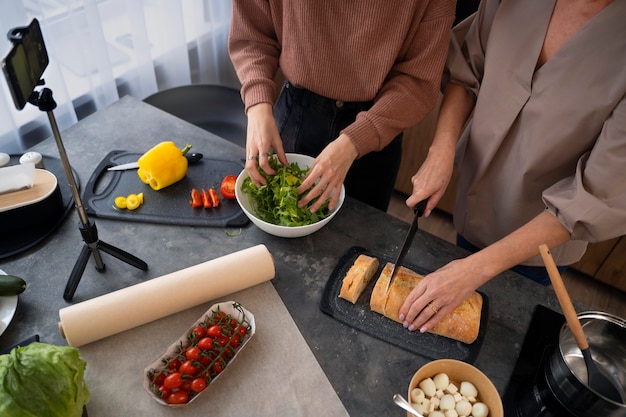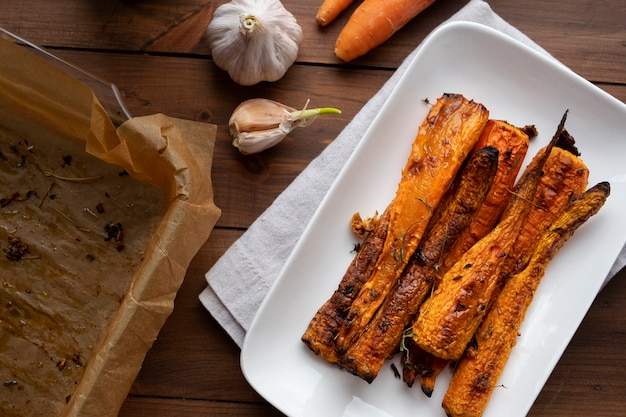As a seasoned foodie, I've always been drawn to the rich, juicy flavour of a perfectly cooked new york strip steak. It's a culinary masterpiece that demands respect, and achieving that "wow" factor requires a deep understanding of cooking times. It's not just about throwing it on the grill and hoping for the best – there's a science to it, a symphony of heat and time.
In this guide, I'll share my personal journey, my tried-and-true techniques, and a few insider tips that I've picked up over the years. We'll explore everything from choosing the right cut to nailing the perfect doneness, and even delve into the best ways to season and rest your steak. Get ready to elevate your steak game, because you're about to become a New York strip master.
(Part 1) The Prime Cut: Choosing Your Steak

The first step is choosing the right New York strip. This isn't just about picking the biggest one you can find. There are a few key things to consider, and believe me, it's worth the extra attention.
1.1 Marbling: The Key to Juicy Flavour
You want a steak that's well-marbled, not just a few scattered streaks of fat. Those little streaks of fat are the secret to a juicy, flavorful steak. They melt during cooking, adding richness and tenderness to every bite. Think of it like the butter in a good pastry – it's what makes it irresistible. Look for a steak that has a consistent pattern of marbling throughout. Don't be afraid to ask your butcher for advice – they're the experts in identifying the best cuts.
1.2 Thickness: Finding the Sweet Spot
Thickness matters, too. You want a steak that's thick enough to hold its own on the grill or in the pan, but not so thick that it becomes a culinary challenge. Aim for a steak that's about 1-1.5 inches thick. This thickness allows for a beautiful sear on the outside while ensuring a juicy, tender interior. It's the perfect balance for a satisfying steak experience.
1.3 "The Look": Finding the Right Vibe
Now, this is a bit more subjective, but I always look for a steak that has a nice, even colour with a slightly "wet" appearance. It shouldn't be dry or discoloured. You want a steak that looks fresh, inviting, and full of life. It should have a certain "vibe," that tells you it's going to be delicious. It's a bit like picking out a ripe fruit at the market - you know it when you see it.
(Part 2) Preparation: The Foundation for Success

You've got your steak, now it's time to get it ready for its culinary transformation. This is where the magic really starts. It's about setting the stage, making sure the steak is primed for a perfect performance.
2.1 Temperature: Bringing it to Room Temperature
This is one of my favorite tips, and it's a simple one. Take your steak out of the fridge about 30 minutes before cooking. Let it come to room temperature. This helps to ensure even cooking, prevents the center from getting cold while the outside is sizzling, and allows for a more consistent internal temperature. Imagine it as letting the steak "warm up" before the big show. It's like giving it a chance to relax and settle in before the heat hits.
2.2 Pat It Dry: Goodbye, Moisture
No one likes a soggy steak. Pat the steak dry with paper towels to remove any excess moisture. You want a dry surface so that the steak sears perfectly and develops that beautiful, crispy crust. Think of it as creating the perfect canvas for your masterpiece. A dry surface helps the heat penetrate the steak more evenly, giving it that satisfying char you crave.
2.3 Seasoning: A Flavorful Symphony
This is where your culinary creativity comes in! I love to keep it simple with salt and pepper, but don't be afraid to experiment. A blend of garlic powder, onion powder, paprika, and a sprinkle of cayenne pepper for a touch of heat is a personal favourite. The key is to season liberally. Salt draws out moisture, which helps create a juicier, more flavorful steak. Season both sides generously and give it a good rub to ensure the spices stick.
(Part 3) cooking techniques: The Dance of Heat and Time

Now comes the exciting part – the actual cooking. This is where the science and art of steak cooking really come together. It's a delicate dance, a balance between heat and time. Get it right, and you'll be rewarded with a steak that's juicy, flavorful, and perfectly cooked. Get it wrong, and well, let's just say you might end up with a tough, dry piece of meat.
3.1 Grill Master: The Outdoor Approach
If you're lucky enough to have a grill, this is your chance to shine. Preheat your grill to high heat – aim for 450-500°F (232-260°C). The intense heat of a high-heat grill is key for achieving that beautiful char and flavorful crust. Place the steak on the grill and cook for about 3-4 minutes per side for medium-rare. You want those beautiful grill marks – they're a sign that your steak is cooked to perfection.
Don't be afraid to move the steak around on the grill to ensure even cooking. You can even use a grill brush to clean the grates before cooking to prevent sticking.
3.2 Pan-Seared Perfection: The Indoor Option
Don’t worry, if you don't have a grill, you can still achieve pan-seared perfection. Grab a cast iron skillet and heat it up until it's smoking hot. This intense heat is essential for creating a beautiful sear. Add a tablespoon or two of oil – I prefer avocado or grapeseed oil for their high smoke point – and let it heat up. Then add the steak to the skillet. Cook for about 4-5 minutes per side for medium-rare.
You'll know your steak is ready when it has a nice, golden-brown crust and the juices run clear when you press it gently. Don't be tempted to move the steak around too much while it's searing. Give it time to develop that beautiful crust. It's a bit of a culinary ballet, letting the steak do its thing in the hot pan.
(Part 4) Doneness: The Art of Internal Temperature
Everyone has their own preference for steak doneness, but it's essential to understand the different levels and how to achieve them. This is where the science meets the art, and it's a crucial part of the process.
4.1 The Doneness Scale: A Guide for Steak Lovers
Here's a quick rundown of the doneness scale and the corresponding internal temperatures:
| Doneness | Internal Temperature (°F) | Internal Temperature (°C) |
|---|---|---|
| Rare | 125-130 | 52-54 |
| Medium-Rare | 130-135 | 54-57 |
| Medium | 140-145 | 60-63 |
| Medium-Well | 150-155 | 65-68 |
| Well-Done | 160 | 71 |
The good news is, you don't have to be a culinary expert to get the doneness right. A meat thermometer is your best friend. It gives you an accurate reading, ensuring that your steak is cooked to your liking. It's a simple tool that makes all the difference, especially if you're new to judging doneness by touch.
4.2 The "Touch Test": A Hands-On Approach
For the more experienced steak cook, there's the "touch test." It's all about feeling the firmness of the steak. A rare steak will feel soft and springy, while a well-done steak will be firm. It's like testing the firmness of a ripe avocado – a subtle difference in texture.
I find that the "touch test" is more reliable when you're working with thicker steaks. It's a bit of a sensory experience, but once you get the hang of it, it can be quite accurate.
(Part 5) Resting: Letting the Steak Relax
Your steak is cooked to perfection, but don't rush to slice and serve it right away. Give it a chance to rest, to relax and redistribute its juices. This is a crucial step, often overlooked, that makes all the difference in achieving a juicy, tender steak.
5.1 The Power of Resting: Juicy and Tender
Think of it like a marathon runner needing a moment to catch their breath. Resting the steak for about 5-10 minutes allows the juices to redistribute throughout the meat. This prevents them from running out when you cut into it, resulting in a juicier, more tender cut. It's a simple act, but it makes a huge difference.
5.2 The Resting Ritual: Wrap it Up
To rest your steak, simply transfer it to a cutting board and loosely tent it with aluminium foil. Think of it as creating a little sauna for your steak. This helps to trap the heat and moisture, allowing the juices to flow back into the meat. It's a bit like giving the steak a gentle massage, allowing it to regain its composure.
(Part 6) Slicing and Serving: The Grand Finale
You've done all the hard work, now it's time to showcase your culinary masterpiece. This is the moment you've been waiting for – the grand finale.
6.1 The Art of Slicing: Respect the Grain
Slicing a steak correctly is crucial for achieving that melt-in-your-mouth texture. Always slice the steak with the grain, cutting across the muscle fibres. This creates tender, juicy slices that melt in your mouth.
Slicing against the grain can result in tough, chewy bites. Think of it as cutting the steak along the direction of the "lines" you can see on the surface. It's like respecting the natural structure of the meat.
6.2 The Presentation: A Culinary Showcase
You've put so much effort into cooking the perfect steak, so don't skimp on the presentation. A simple plate with a bed of your favorite sides can elevate your steak to a whole new level. Think roasted vegetables, creamy mashed potatoes, or a simple salad. Let your culinary creativity shine!
And don't forget a splash of your favorite sauce. Whether it's a classic Béarnaise or a tangy chimichurri, a good sauce can add a wonderful flavour dimension to your steak.
(Part 7) Additional Tips for steak mastery
Here are a few more tips and tricks to help you elevate your steak game to the next level. These are little secrets I've picked up over the years, and they're sure to make a difference.
7.1 Embrace the Cast Iron: A Grilling Legend
For the best sear, a cast iron skillet is your best friend. Its ability to retain heat ensures that your steak gets a beautiful, crispy crust. Just make sure it's well-seasoned to prevent sticking. A well-seasoned cast iron skillet is a culinary treasure, and it's worth the investment.
7.2 The Power of Herbs: Adding Depth of Flavour
Don't be afraid to experiment with different herbs. Fresh rosemary, thyme, or oregano can add a wonderful complexity to your steak. You can even create a herb butter to spread on top for an extra flavour punch. Think of herbs as the secret ingredients that elevate your steak from good to amazing.
7.3 Resting Is Key: Don't Skip It!
Remember, resting is not optional. It's a crucial step in ensuring a juicy, flavorful steak. Don't rush the process, and let your steak relax for at least 5 minutes before slicing. Think of it as a reward for your patience.
(Part 8) FAQs: Answering Your Burning Questions
Let's face it, sometimes we have questions, and that’s totally okay. Here are some frequently asked questions about cooking new york strip steak, and I'll provide detailed answers to help you become a confident steak master.
8.1 What is the best way to cook a New York strip steak?
There's no one "best" way. It all depends on your preference and equipment. Whether you're grilling, pan-searing, or even using the oven, the key is to use high heat to get a beautiful sear and follow the cooking times based on your desired doneness. Experiment and see what works best for you.
8.2 What is the best temperature to cook a New York strip steak?
Again, it depends on your preferred doneness. For rare, aim for 125-130°F (52-54°C). For medium-rare, aim for 130-135°F (54-57°C). Use a meat thermometer to check the internal temperature for accurate results.
Remember, the internal temperature will continue to rise slightly after you remove the steak from the heat, so it's important to remove it from the heat slightly before it reaches your desired temperature.
8.3 How long should I cook a New York strip steak?
The cooking time will vary depending on the thickness of the steak and your desired doneness. As a general guideline, for a 1-inch thick steak, you can expect to cook for about 4-5 minutes per side for medium-rare. Adjust the cooking time accordingly for different thickness and doneness levels.
8.4 What is the best way to season a New York strip steak?
Salt and pepper are the classics, but feel free to get creative with different herbs and spices. Garlic powder, onion powder, paprika, and even a sprinkle of cayenne pepper can add amazing depth of flavour. Season liberally, as the salt will help to draw out moisture and create a juicier steak.
8.5 How do I know if a New York strip steak is cooked?
You can use a meat thermometer to check the internal temperature, or you can use the "touch test" by pressing the centre of the steak. A rare steak will feel soft and springy, while a well-done steak will be firm. Pay attention to the colour of the juices, too. Clear juices indicate that the steak is cooked to the desired doneness, while pink juices mean it needs more cooking time.
Remember, cooking a New York strip steak is a journey, a culinary adventure that requires a bit of patience, attention to detail, and a dash of creativity. Don't be afraid to experiment, to find what works best for you, and most importantly, to enjoy the process. Happy grilling (or pan-searing)!
Everyone is watching

How to Cook Frozen Lobster Tails Perfectly: A Step-by-Step Guide
RecipesLobster. Just the word conjures up images of lavish meals, special occasions, and a taste of luxury. But let's...

Pigs in a Blanket Cooking Time: How Long to Bake for Perfect Results
RecipesAh, pigs in a blanket. Just the name conjures up images of those delightful little parcels of crispy pastry en...

Pork Fillet Cooking Time: How Long to Cook It Perfectly
RecipesPork fillet, or tenderloin as it's sometimes called, is a real favourite in our house. It's so versatile, and...

The Ultimate Guide to Cooking Sweet Potatoes: From Roasting to Mashing
RecipesSweet potatoes. Just the name conjures up images of warm, comforting dishes, bursts of vibrant color, and a to...

The Ultimate Guide to Tender, Juicy Pulled Pork
RecipesRight, let's talk pulled pork. It's one of those dishes that just screams "comfort food," doesn't it? I mean...
